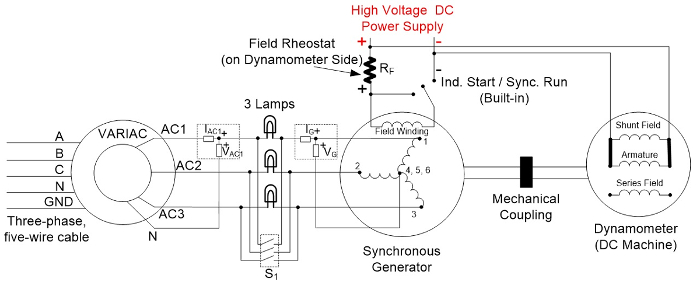交流同步机同步
资料来源: Bazzi, 康涅狄格州大学电气工程系, 斯托斯, CT。
三相绕线-转子同步发电机是全球电力的主要来源。为了发电, 他们需要一个原动力和一个刺激者。原动力可以是由流体 (气体或液体) 纺成的涡轮, 因此流体的来源可以是通过长的喷嘴从大坝流出的水, 用烧焦的煤蒸发的水蒸气等。大多数发电厂包括煤、核能、天然气、燃料油和其他使用同步发电机。
本实验的目的是了解调整三相同步发电机电压和频率输出的概念, 然后与电网同步。同时也证明了电场电流和转速变化对发电机输出功率的影响。
1. 原动力初始化
本实验中的原动力是测功机, 它作为电机旋转发电机转子 (场)。
- 确保三相断开开关、同步电机开关和直流电机开关全部关闭。
- 检查调压器是否在0%。
- 将调压器线连接至三相插座, 并将安装在图1中的设置接通。
- 将同步计算机端上的三相开关用作 "S1。
- 请注意, "S1" 和三灯设置是并行的。
- 还要注意数字功率计探头的极性。
- 检查 "启动/运行" 开关是否处于 "开始" 位置。
- 将 "RF" 设置为最大电阻。
- 将调压器保留在 0%, 并关闭 "S1"。
- 打开三相断开开关。
- 打开高压直流电源。
- 确保从供应终端的所有连接都是明确的。
- 按电源上的 "V/I" 按钮以显示电压和电流操作点。调整电压旋钮到 15
跳至...
此集合中的视频:

Now Playing
交流同步机同步
Electrical Engineering
21.5K Views

电气安全预防措施和基本设备
Electrical Engineering
144.5K Views

磁性元件的特性
Electrical Engineering
15.0K Views

电源杆板介绍
Electrical Engineering
12.4K Views

dc/dc 升压转换器
Electrical Engineering
56.7K Views

dc/dc 降压转换器
Electrical Engineering
21.1K Views

反激式转换器
Electrical Engineering
13.2K Views

单相变压器
Electrical Engineering
20.1K Views

单相整流器
Electrical Engineering
23.4K Views

晶闸管整流
Electrical Engineering
17.4K Views

单相逆变器
Electrical Engineering
17.9K Views

直流电机
Electrical Engineering
23.3K Views

交流异步电动机特性
Electrical Engineering
11.6K Views

变频调速交流感应电机
Electrical Engineering
6.9K Views

交流同步电机特性
Electrical Engineering
14.2K Views
版权所属 © 2025 MyJoVE 公司版权所有,本公司不涉及任何医疗业务和医疗服务。
